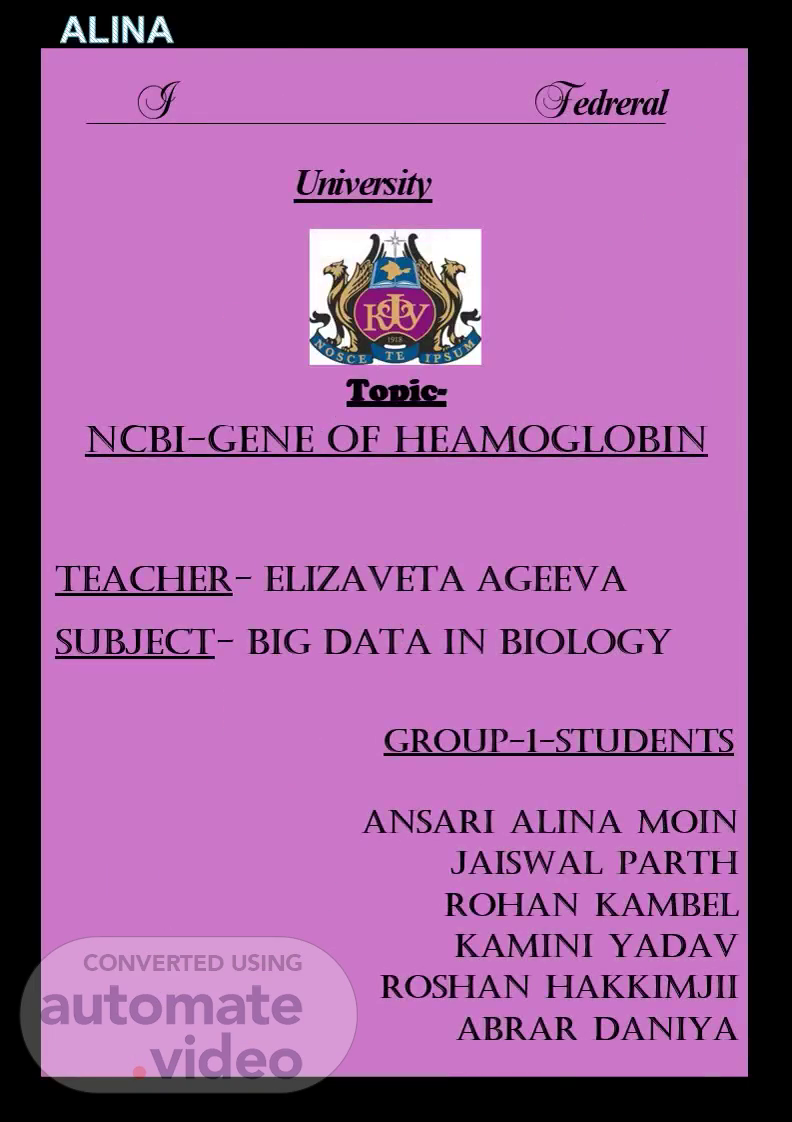
V. . Vernadeskiy Crimean
Scene 1 (0s)
V. . V e r nad e s k i y Crimean. edreral. U n i v e r s i t y.
Scene 2 (45s)
sua es OWOH UBVONOHONOH ONOH ONOH. sua es OWOH UBVONOHONOH ONOH ONOH.
Scene 3 (2m 47s)
HBG1. HBG1. ID: 3047. CHROMOSMAL LOCATION OF THE GENE Location: 11p15.4 Exon count: 3 The beta globin (HBB) gene maps in the short arm of chromosome 11, in a region containing also the delta globin gene, the embryonic epsilon gene, the fetal A- gamma and G- gamma genes, and a pseudogene (ψB1). Beta- thalassemias are heterogeneous at the molecular level. HBB hemoglobin subunit beta Chromosome 11, NC_000011.10 ID: 3043 [ Homo sapiens (human)] (5225464..5227071, complement) hemoglobin subunit.
Scene 4 (3m 33s)
Some normal hemoglobin types are; Hemoglobin A (Hb A), which is 95–98% of hemoglobin found in adults, Hemoglobin A2 (Hb A2), which is 2–3% of hemoglobin found in adults, and Hemoglobin F (Hb F), which is found in adults up to 2.5% and is the primary hemoglobin that is produced by the fetus during pregnancy. Haemoglobin C (HbC) is one of the commonest structural haemoglobin variants in human populations. The highest frequencies were found in West Africa but HbC was commonly found in other parts of the continent. The expected annual numbers of AC and CC newborns in Africa were 672,117.
Scene 5 (4m 15s)
Single nucleotide polymorphisms (SNPs)? Single nucleotide polymorphisms, frequently called SNPs (pronounced “snips”), are the most common type of genetic variation among people. Each SNP represents a difference in a single DNA building block, called a nucleotide. For example, a SNP may replace the nucleotide cytosine (C) with the nucleotide thymine (T) in a certain stretch of DNA. Most commonly, these variations are found in the DNA between genes. They can act as biological markers, helping scientists locate genes that are associated with disease..
Scene 6 (6m 6s)
NUMBER OF HEMOGLOBIN IN AMINO ACIDS. ROSHAN.
Scene 7 (7m 11s)
POLYMORPHISM - TYPE Genetic polymorphism is defined as the inheritance of a trait controlled by a single genetic locus with two alleles, in which the least common allele has a frequency of about 1% or greater. Blood groups are examples of genetic polymorphism, such as the ABO blood group system. Amongst > 20,000 genes in the human genome, beta haemoglobin (HBB) gene is the most polymorphic gene, containing approximately 176 SNVs per kilobase (kb) with the highest density of SNVs within its coding region. Various types of polymorphisms include: single nucleotide polymorphisms (SNPs) small- scale insertions/deletions polymorphic repetitive elements microsatellite variation.
Scene 8 (8m 1s)
Polymorphisms are generated by mutations in the genes for these enzymes, which cause decreased, increased, or absent enzyme expression or activity by multiple molecular mechanisms. Three mechanisms may cause polymorphism: Genetic polymorphism – where the phenotype of each individual is genetically determined A conditional development strategy, where the phenotype of each individual is set by environmental cues A mixed development strategy, where the phenotype is randomly assigned during development.
Scene 9 (8m 42s)
The globins are a superfamily of heme- containing globular proteins , involved in binding and/or transporting oxygen. These proteins all incorporate the globin fold, a series of eight alpha helical segments. Two prominent members include myoglobin and hemoglobin. Subfamilies Leghaemoglobi n InterPro : IPR001032 Myoglobi n InterPro : IPR002335 Erythrocruori n InterPro : IPR002336 Hemoglobin, bet a InterPro : IPR002337 Hemoglobin, alph a InterPro : IPR002338 Myoglobin, trematode typ e InterPro : IPR011406 Globin, nematod e InterPro : IPR012085 Globin, lamprey/hagfish typ e InterPro : IPR013314 Globin, annelid- typ e InterPro : IPR013316 Haemoglobin, extracellula r InterPro : IPR014610.
Scene 10 (9m 43s)
Gregor Mendel: the 'father of genetics.. Hemoglobin (Hb) was accidentally discovered by Hünefeld in 1840 in samples of earthworm blood held under two glass slides. He occasionally found small plate- like crystals in desiccated swine or human blood samples.These crystals were later named as “Haemoglobin” by Hoppe- Seyler in 1864..
Scene 11 (10m 15s)
DANIYA.